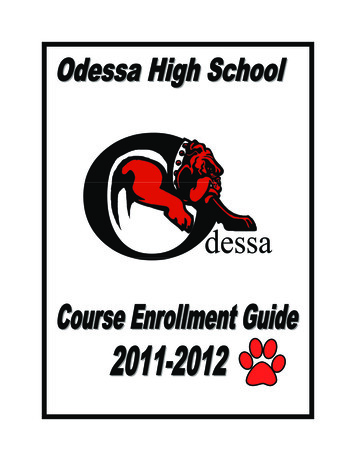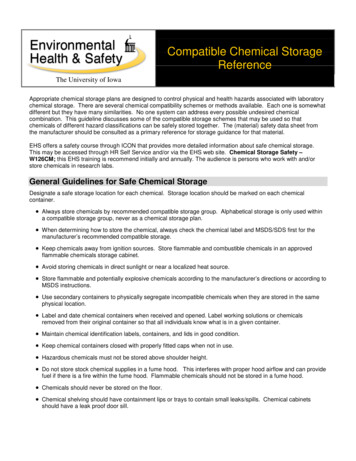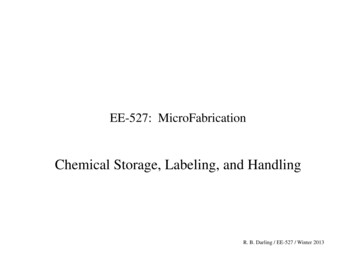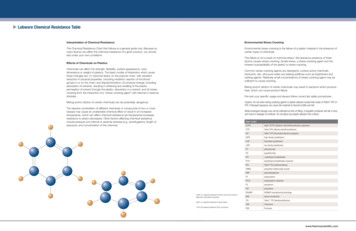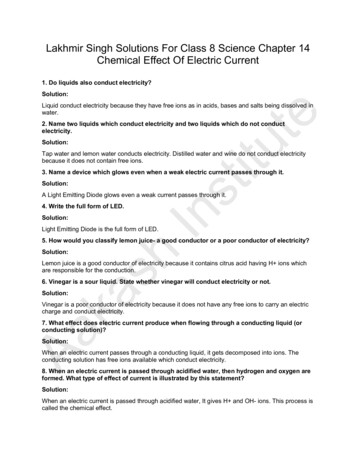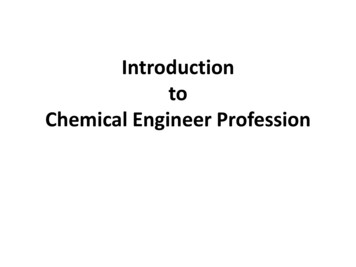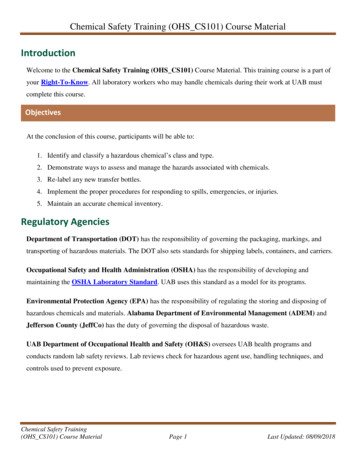
Transcription
Chemical Safety Training (OHS CS101) Course MaterialIntroductionWelcome to the Chemical Safety Training (OHS CS101) Course Material. This training course is a part ofyour Right-To-Know. All laboratory workers who may handle chemicals during their work at UAB mustcomplete this course.ObjectivesAt the conclusion of this course, participants will be able to:1. Identify and classify a hazardous chemical’s class and type.2. Demonstrate ways to assess and manage the hazards associated with chemicals.3. Re-label any new transfer bottles.4. Implement the proper procedures for responding to spills, emergencies, or injuries.5. Maintain an accurate chemical inventory.Regulatory AgenciesDepartment of Transportation (DOT) has the responsibility of governing the packaging, markings, andtransporting of hazardous materials. The DOT also sets standards for shipping labels, containers, and carriers.Occupational Safety and Health Administration (OSHA) has the responsibility of developing andmaintaining the OSHA Laboratory Standard. UAB uses this standard as a model for its programs.Environmental Protection Agency (EPA) has the responsibility of regulating the storing and disposing ofhazardous chemicals and materials. Alabama Department of Environmental Management (ADEM) andJefferson County (JeffCo) has the duty of governing the disposal of hazardous waste.UAB Department of Occupational Health and Safety (OH&S) oversees UAB health programs andconducts random lab safety reviews. Lab reviews check for hazardous agent use, handling techniques, andcontrols used to prevent exposure.Chemical Safety Training(OHS CS101) Course MaterialPage 1Last Updated: 08/09/2018
Chemical Safety Training (OHS CS101) Course MaterialRecognizing HazardsHazards DefinedHazardous SubstanceA hazardous substance is a material or substance that poses a physical or health hazard. Health Hazardsoccur when a chemical produces an acute or chronic health effect on exposed individuals. Physical propertiesof a substance determine a Physical Hazard.Physical Hazard Examples:Health Hazard Examples: Nephrotoxin: A toxic chemical that damages the kidneys (e.g., Cisplatin, Aminoglycoside,Antibiotics, Indomethacin). Hepatotoxin: A toxic chemical that damages the liver (e.g., Ethanol, Halothane, CarbonTetrachloride). Teratogen: A toxic chemical that causes malformation of an embryo (e.g., Alcohol).Chemical Safety Training(OHS CS101) Course MaterialPage 2Last Updated: 08/09/2018
Chemical Safety Training (OHS CS101) Course MaterialFor more detailed information on health and physical hazards, see Two Group of Hazards.Acute vs. ChronicAcute Hazards cause immediate harm (e.g., Carbon Monoxide poisoning, Cyanide inhalation, etc.). ChronicHazards do not cause immediate harm (e.g., Mesothelioma from Asbestos exposure, lung cancer fromsmoking, etc.).Routes of ExposureThe four routes of exposure are ingestion, inhalation, injection, and skincontact.ToxicityThe degree to which a toxic chemical can cause damage. Dosage,duration, and exposure to chemicals affect toxicity.Chemical Safety Training(OHS CS101) Course MaterialPage 3Last Updated: 08/09/2018
Chemical Safety Training (OHS CS101) Course MaterialLabelingRequirementsThe original label of the chemical is the best source ofinformation to acquire knowledge about the hazards,emergency information, and storage. Original labels arerequired to have the following: Product Identifier Supplier Identification Precautionary Statements Pictograms Signal Words: (Danger or Warning). Danger meansthere is a severe hazard present and warning there isa moderate to low hazard present. Hazard Statement Supplemental InformationChemical Safety Training(OHS CS101) Course MaterialPage 4Last Updated: 08/09/2018
Chemical Safety Training (OHS CS101) Course MaterialPictogramsChemical Safety Training(OHS CS101) Course MaterialPage 5Last Updated: 08/09/2018
Chemical Safety Training (OHS CS101) Course MaterialNFPA DiamondThe National Fire Protection Association (NFPA)Diamond helps determine if any specialized equipment, procedures, or precautions areneeded. The four divisions are typically color-coded with red (flammability), blue (levelof health hazard), yellow (chemical reactivity) and white (special hazards).Examples of special hazards: OX: Burns without an air supply W: Reacts with water violently SA: Simple Asphyxiant GasWithin these different color-coded squares you may see a number (1-4) or a letter. Higher thenumber, the more severe the hazard will be.Secondary ContainersYou can use ChemWatch to print new labels. Secondary containersXylene(e.g., squeeze bottles, spray bottles, flasks, tubes, etc.) are required toIrritant and Flammable!have:Toxic to blood, kidneys,nervous system, liver Same name as the original container All hazard class and target organ information as listed on theDate Transferred 06/30/2017original bottle Date transferredSafety Data Sheets (SDS)UAB has subscribed to a chemical database called ChemWatch. ChemWatch allows an SDS to be accessiblefrom any computer on the UAB Campus, within UAB Medical System, or connected via VPN. Employees arestrongly recommended to review the SDS before starting to work with any new chemicals. An SDS must beavailable to all employees working in the area. Contact UAB’s Department of Occupational Health and Safety(OH&S) at (205) 934-2487 if you need assistance in obtaining Safety Data Sheets (SDS).Chemical Safety Training(OHS CS101) Course MaterialPage 6Last Updated: 08/09/2018
Chemical Safety Training (OHS CS101) Course MaterialAn SDS will contain: Chemical Name and Identification Hazard Identification: Pictograms and Signal Word Personal Protective Equipment (PPE) Disposal RequirementsThe hazard severity ratings on SDS’s are the opposite of the NFPA System. Thenumber one on an SDS is the words and five is the least hazardous.Minimizing HazardHierarchy of ControlsElimination vs. SubstitutionElimination is removing a hazard (e.g., not using Etherin your process). Substitution is using a less hazardousmaterial (e.g., using Hexane in place of the knowncarcinogen Benzene).Chemical Safety Training(OHS CS101) Course MaterialPage 7Last Updated: 08/09/2018
Chemical Safety Training (OHS CS101) Course MaterialEngineering ControlsIf a hazard cannot be eliminated or substituted, the best approach is to use engineering controls to keep thehazard from reaching the worker. Examples are fume hoods, glove boxes, and biosafety cabinets.Administrative (Work Practice) Controls)Chemical Hygiene Plan (CHP)A detailed written plan explaining the hazards present, how to manage them safely, and be specific to theindividual lab or research group. Must be available to all employees working in the area.Chemical Hygiene Officer (CHO)Department heads or the Principal Investigator (PI) will appoint someone to this position. A CHO is alsoknown as a Lab Coordinator. A CHO is responsible for: Serving as liaison with UAB Occupational Health and Safety (OH&S). Implementing, updating, and administering the CHP (including the provisions for obtaining priorapproval for dangerous procedures).Standard Operating Procedures (SOP)An SOP is a set of step-by-step instructions that help employees carry out routine laboratory operations,improve efficiency, and reduce miscommunication. PI’s or Department Head’s develops the SOP, ensurescontrol measures are in place, and there is adequate protective equipment. OH&S reviews these SOPs duringthe annual laboratory audits and make recommendations.Chemical Safety Training(OHS CS101) Course MaterialPage 8Last Updated: 08/09/2018
Chemical Safety Training (OHS CS101) Course MaterialStorageYou should store chemicals according to compatibility and hazard class. Storing them alphabetically, or bycarbon number, or by physical state, etc. are not acceptable practices. OH&S recommends segregating themby EPA Segregation Guidelines. Storing flammable liquids in quantities greater than 10 gallons in a flammable storage cabinet. Acids and bases stored separately and storing oxidizers away from organic materials that could reactto cause a fire. Always store corrosive and other hazardous chemicals below eye level. Never store chemicals on thefloor. Use secondary containment for liquids.Special RequirementsExplosivesThere are two types of explosive chemicals.1. Explosive Chemicals: Designed, produced, or used as an explosive (e.g., TNT, Explosive Bolts,Bullets, Blasting Caps, and Fireworks). Research labs do not use these.2. Potentially Explosive Chemicals (PECs): Over time, these chemicals become explosive whensubjected to heat, light, friction, or mechanical shock (e.g., Diethyl Ether, Tetrahydrofuran, SodiumAmide, and Picric Acid).Peroxide FormersPeroxide Formers are a class of chemicals with high instability and are one of the most dangerous chemicalsused in laboratories. Shock, heat, or friction can cause unexpected explosions of peroxide forming chemicals.Since peroxide crystals form on the lid and detonate when the cap is twisted, it is advised not to open acontainer if you suspect the formation of peroxides. Some common classes of compounds that form peroxidesinclude Ethers, Tetrahydrofuran, Aldehydes, and Acetals. Ether is no longer used as an anesthetic agent. Ifyou need more information on animal anesthesia, please contact the ARP at (205) 934-3553.Chemical Safety Training(OHS CS101) Course MaterialPage 9Last Updated: 08/09/2018
Chemical Safety Training (OHS CS101) Course MaterialYou should do the following: Limiting the number of containers stored in the lab. Ensuring that the following is on the label:o Warning “PEROXIDE FORMER”o Date of purchaseo Date of openingo Required discard date (within 24 months) Storing in airtight containers away from heat and light. Inspecting for signs of peroxide formation (e.g., crystallization, discoloration, stratification, etc.). Testing all opened containers of such materials every three months for peroxides. Obtain test stripsfrom laboratory or safety supply vendors. Disposing of containers before the expiration date.Particularly HazardousUse of particularly hazardous substances, such as select carcinogens, reproductive toxins or acute toxins mayrequire prior review/approval to ensure adequate controls are in place to protect the workers. OH&S will beavailable to review and make recommendations for additional employee protection protocols.UAB Chemical InventoryOH&S maintains an online chemical inventory that meets Federal and State requirements. This systemutilizes barcodes and a web-based interface. The chemical inventory allows users to track the chemicals thatare on-hand. Also, the inventory fulfills an agreement with local emergency response agencies, allowing themto access information regarding possible chemical hazards. All hazardous chemicals with an NFPA rating oftwo or above belong in the chemical inventory. The users are required to update the inventory every sixmonths.If you are changing labs and need to move your inventory, you should contact OH&S first. Contact OH&S at(205) 934-2487 if you have questions or need assistance with your chemical inventory.Chemical Safety Training(OHS CS101) Course MaterialPage 10Last Updated: 08/09/2018
Chemical Safety Training (OHS CS101) Course MaterialPersonal Protective Equipment (PPE)All persons, including visitors, who enter areas where hazardous chemicals are used or stored, must wearPPE. All PPE should be kept inside the lab to minimize the possibility of spreading contaminants to publicareas. Your PPE is the “last line of defense” against potential exposures. It is never a substitute forengineering controls or strict work practices.Lab Coats Must never be worn outside the work area. Protect your skin and personal clothing from any incidental contact. Provide a removable barrier in the event of an incident involving aspill or splash of hazardous substances. Must be offered in different types and styles. Your selection mustmatch the type of hazard present in the lab. Must be clean, buttoned, and long-sleeved to provide limitedprotection from chemical splashes. Must be of 100% cotton or treated with a flame retardant material. Wear an impenetrable apron and sleeves for more protection if needed. When working with highlytoxic substances, you must tuck the sleeves into the gloves.GlovesSelecting the right glove depends on yourwork, substance used, SDS Recommendation,and breakthrough time. No one type of gloveprotects against all chemicals. You should: Check gloves for holes and tears before use. Change disposable gloves as soon as they become contaminated. Wash hand with soap and water before leaving the lab.Chemical Safety Training(OHS CS101) Course MaterialPage 11Last Updated: 08/09/2018
Chemical Safety Training (OHS CS101) Course MaterialGlasses, Goggles, and ShieldsBefore donning glasses, goggles, or face shields make sure that you are wearing theappropriate one for the job. Remember, safety glasses do not protect from chemicalsplashes. You should be: Using safety glasses whenever there is a chance of objects striking the eye.They are not appropriate protection from a chemicalsplash. Wearing splash goggles when working with liquids. Wearing a face shield with splash goggles when thesplash hazard is high, or the chemicals areparticularly dangerous.RespiratorsThe selection and use of respirators require specialized training. Before wearing a respirator, employees mustundergo medical screening, training, and testing. Anyone who needs to wear a respirator for their work shouldcontact OH&S at (205) 934-2487.Preparing for EmergenciesSafety EquipmentFire ExtinguisherA fire extinguisher is a device that dispenses water, foam, gas, or other materialto extinguish a fire. You can find them in hallways, meeting rooms, and nearexit doors, etc. Fire extinguishers must be selected and positioned based on thepossible type and size of the fire that can occur. Class A: NFPA recommends that locations such as offices, classrooms,and assembly halls contain a Class A Extinguisher. OSHA requires thatall persons have access to this type of extinguisher within 75 feet of theirworkspace.Chemical Safety Training(OHS CS101) Course MaterialPage 12Last Updated: 08/09/2018
Chemical Safety Training (OHS CS101) Course Material Class B: NFPA recommends that locations such as workshops, storage areas, research operations,garages, etc., contain a Class B Extinguisher. OSHA requires that all persons have access to this typeof extinguisher within 50 feet of their workspace.Eyewash StationAn eyewash station is a device that protects workers against chemical-relatedeye injuries. Most stations have a shower-like sprayer that, when pressed,sprays water down on the worker’s eyes. Eyewashes should be inspectedweekly by the lab personnel and maintained according to the manufacturer’sinstructions. For more information, see Emergency Eyewash Testing.Safety ShowerA safety shower is a device that washes an individual who has come into contactwith hazardous chemicals. A user may need to remove contaminated clothing.Safety showers are inspected annually by UAB Maintenance.SpillsSmall vs. LargeSpills of 500ml or less are considered small. Spills of more than 500mlare considered large. However, spills of less than 500ml may beregarded as large if the material involved is particularly hazardous.Chemical Safety Training(OHS CS101) Course MaterialPage 13Last Updated: 08/09/2018
Chemical Safety Training (OHS CS101) Course MaterialSpill KitsPurchase or create your spill kit if the laboratory or area does not have one. However, when purchasing a spillkit, make sure that you get one that is best suited for your lab and the hazards in it. Chemical and biologicalspill kits are available to purchase from most vendors. For more information on spills, spill kits, and cleanupreview see Emergency Spill Kits.The OH&S Spill Response TeamThe OH&S Spill Response Team has been specially trained to handle hazardous chemical spills. The OH&SSupport Facility Manager will contact the Spill Response Team, which will have full authority over thecleanup operation. The OH&S Support Facility Manager or his designee will be responsible for calling anyadditional personnel needed at the site of the spill. Anyone deliberately hindering the Spill Response Team atthe site of a spill is jeopardizing the health and safety of other UAB employees, and will be subject todisciplinary action.Call OH&S at (205) 934-2487 or UAB Police at (205) 934-3535 (these apply to all emergencies).Calling 911 from your cell phone, will notify Birmingham Police and delay the response time.Chemical Safety Training(OHS CS101) Course MaterialPage 14Last Updated: 08/09/2018
Chemical Safety Training (OHS CS101) Course MaterialConclusionThis section concludes the course material for the Chemical Safety (OHS CS101) training course. If youhave not taken the assessment, please do so now. You must score 90% or higher to pass.Other Training Compressed Gases: If you are handling, storing, packing, or manifesting compressed gases you mustcomplete the Managing Compressed Gas Cylinders (OHS OHS200) training course. Hazardous Waste: If you are handling, storing, packing, or manifesting hazardous waste, you mustcomplete the Hazardous Waste Handling and Packing (OHS CS055) training course. Biosafety Cabinets and Fume Hoods: Anyone that will be conducting work or research in aBiosafety Cabinet, Fume Hood, or Clean Air Station, must completeBiosafety Cabinets and Fume Hoods (OHS BIO304). Pyrophoric Chemicals: If you are handling, storing, packing, or manifesting pyrophoric chemicals,you must complete the Working Safely with Pyrophoric Chemicals at UAB (OHS CS305) trainingcourse.OH&S has many training courses available to all UAB active employees and students. There is a decisiontree to assist you in choosing the right course to match the knowledge/skills you may need at work every day.If you have any questions or comments, contact OH&S at (205) 934-2487.Chemical Safety Training(OHS CS101) Course MaterialPage 15Last Updated: 08/09/2018
Aug 09, 2018 · Chemical Safety Training (OHS_CS101) Course Material Chemical Safety Training (OHS_CS101) Course Material Page 1 Last Updated: 08/09/2018 Introduction Welcome to the Chemical Safety Training (OHS_CS101) Course Material. This training course is a part of your Right-To-Know. All laborator


